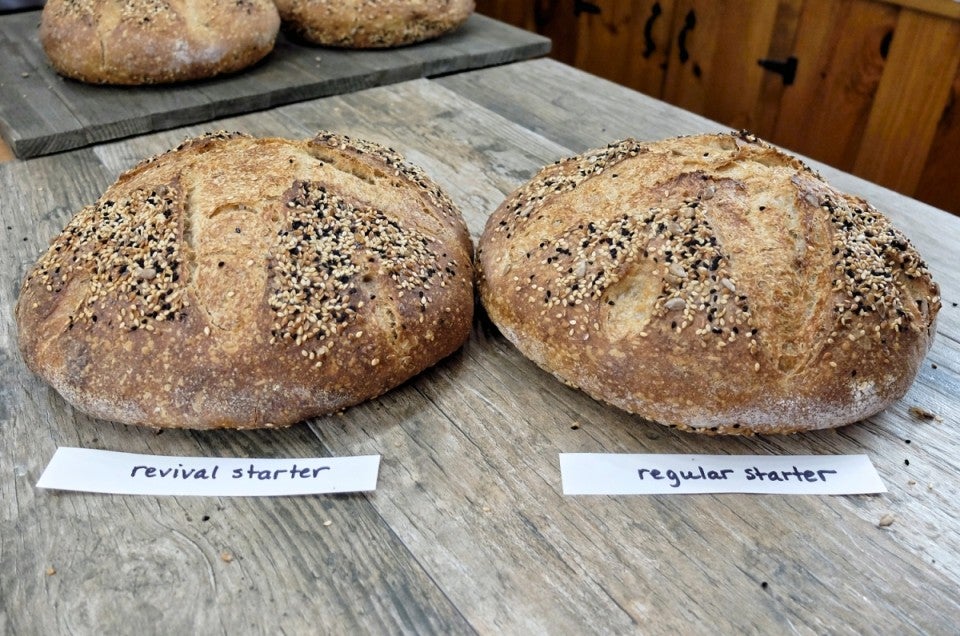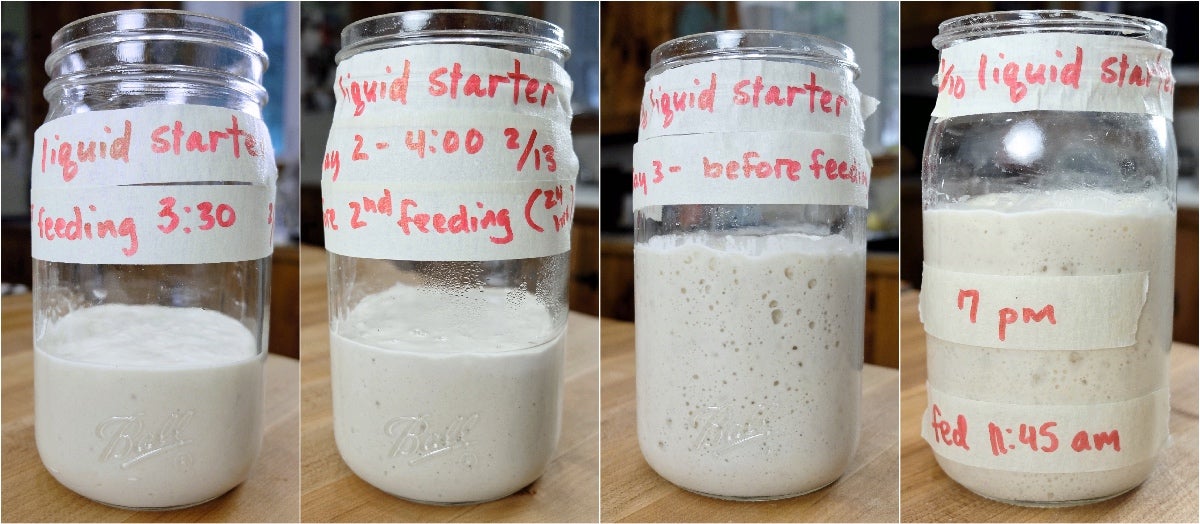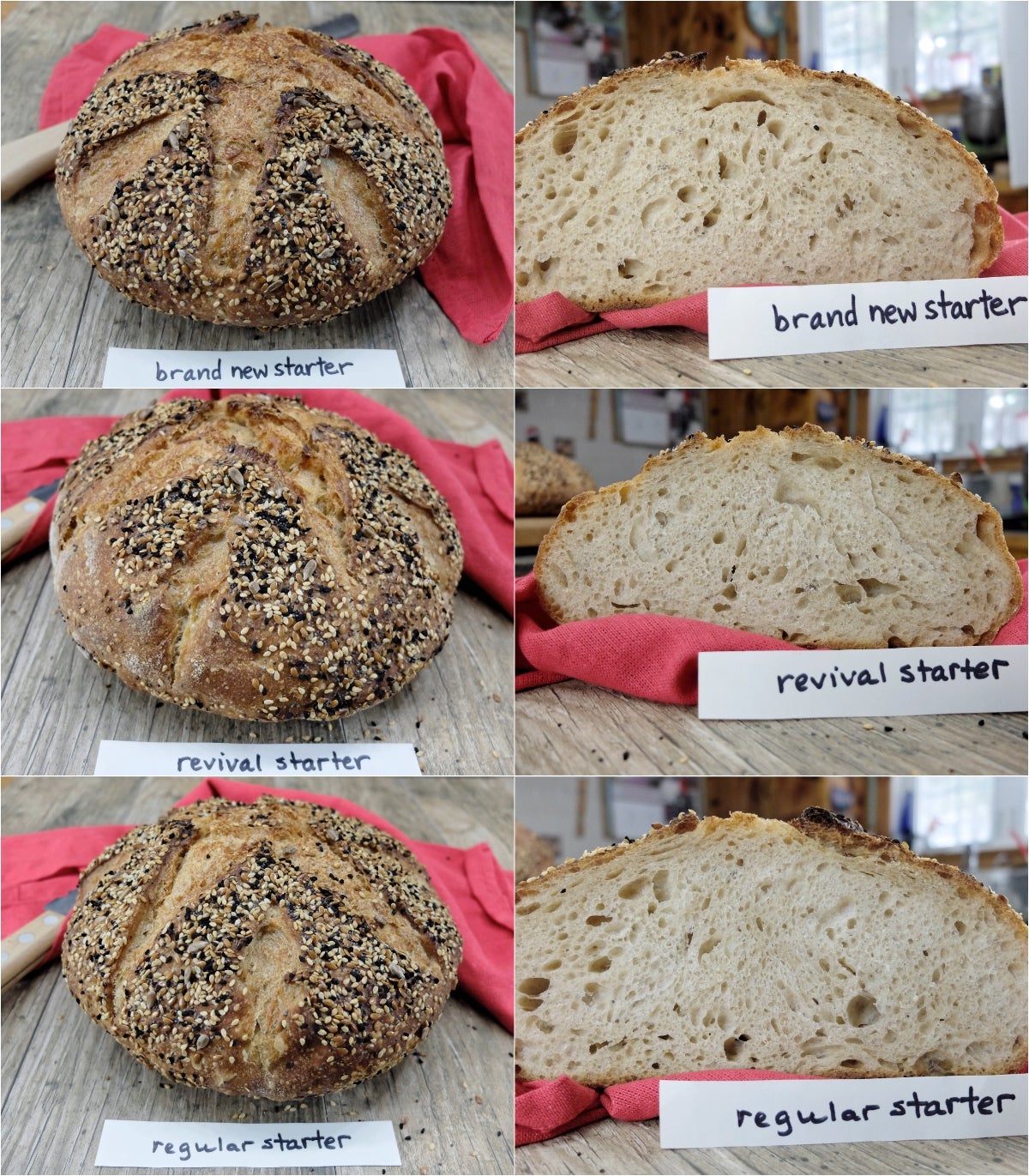


In our first sourdough starter troubleshooting post we tackled sourdough starter viability, and what will and won't cause your starter's demise. We also found out what a spoiled starter looks like, and how to know when it's time to throw it out and start over.
Today we'll take on the thorny question of whether it's worthwhile to try to revive an old but struggling starter — or if it's best to start over.
Creating your own starter from scratch is exciting and even a little magical; for details, see our step-by-step guide to creating a sourdough starter.
Simply mixing flour and water allows friendly bacteria and wild yeast to join forces and establish a balanced ecosystem that is able to impart great flavor and rise to your sourdough baking.

During the 6 to 10 days that it takes to get your starter up and running, it's a little more vulnerable to bacterial intruders and mold because it hasn't yet developed the defenses of a mature starter. But once fully developed, a well-maintained starter will readily fend off unwanted invaders and is very unlikely to spoil.
What if you inherited an old starter from your grandma and it's looking a little like it might be at death's door?

Sourdough authorities argue that there's nothing sacred about an old starter; a freshly developed "mature" starter will impart just as much flavor and rise to your bread.
Starting over with a new starter will get you back to baking great sourdough bread in a little over a week. So why take on the unpredictable task of trying to resurrect a sickly starter?
And is it even possible to thoroughly revive a starter that's sorely neglected?
Let's find out.


I start with two very neglected starters. Both starters (one all-purpose, one whole wheat) had been well-maintained until they were left at room temperature for a full month without being fed.
Why test both a white and a whole wheat starter? Starters can be maintained with all different types of flour, so I wanted to see if a whole wheat starter responded in the same way as a starter fed with all-purpose flour.


I pour the dark hooch off the neglected starters, and feed them following the feeding schedule called for in our sourdough starter recipe.
The revived starters smell a little "off" at first, but not awful; think vinegary sour, with a slightly unpleasant edge. Within four days they're rising well and have a nice, mildly tangy aroma. My theory is that both the acidity and the maturity of the neglected starters helps them fight off unwanted bacteria at the beginning of the process, which might allow for a faster return to a healthy and balanced starter.

By way of comparison, I also begin a starter from scratch. My brand-new starter is able to keep up in terms of rise. However, after four days it still smells a little funky and doesn't seem quite ready for baking bread.
On Day 4 (after only four feedings) I bake Naturally Leavened Sourdough Bread using my revived starters (which I mix together for the test), and my regularly well-maintained starters.


The results are a little shocking: two beautiful and delicious loaves. Both loaves taste mildly sour, although taste testers agree that the revived-starter loaf is slightly tangier.
On Day 5, after a total of six feedings, I try another test bake—this time including the brand-new starter; the revived starters, and my well-maintained regular starter.

Again, the results are surprising: three nice loaves, each with a similar rise and crumb structure. The only real difference is in the flavor of the breads. Each has mildly sour flavor, but the brand-new starter yields a slightly blander loaf.
It's definitely worth trying to revive a neglected starter (so long as it shows no signs of contamination). Pour off any discolored hooch, and start feeding it twice a day at room temperature. If it rises well and has a good aroma after three to four days, you're back in business!
We'd love to hear your own sourdough starter stories and questions below. Did you revive your starter from the brink of death? How long did it take? Is it thriving now?
For more information, please check out our first sourdough starter troubleshooting post.


July 20, 2023 at 1:16pm
I have a new starter, that I have been struggling with for about 10 days. It was quick to rise when I first started it, but then it went "inactive" around day 4, just producing some small bubbles, but not doing much else. It is sitting on my kitchen counter and the kitchen is around 76-79 degrees. I've been following a 1:1:1 ratio, weighing everything (60g of each), and feeding it every day. I started it with regular all-purpose flour as that is all I had on hand, and continued that way until yesterday when I decided to try some whole wheat flour to try and kick start it. When I fed it today, it was still just producing small bubbles. The smell is actually quite nice, and smells somewhat like honey, so I figure I must be on the right track. Do I just need to be patient? When do I switch back over to the all-purpose flour? Should I be feeding it more often?
I am the first to admit that patience is not my strong suit and had, perhaps overly optimistically, hoped my starter would be ready by this weekend.
July 21, 2023 at 3:50pm
In reply to I have a new starter, that I… by Cate (not verified)
Hi Cate, I'm sorry to hear you're having trouble getting your starter up and running! Patience is definitely warranted, and if you're feeding only once a day with the whole wheat flour, I would continue on with this feeding routine.
However, because your house is so warm, consider feeding with cool water and keep an eye on your starter. At you room temperature, your starter is more likely to rise and fall within a shorter period of time, and you might miss this activity if you're not watching it carefully. When starter is allowed to rise and fall, the end result looks a lot like what you're describing (no apparent rise, with a lot of small bubbles on the surface). If it is rising, you may also notice a thinner consistency and a watermark around the side of the container to indicate that the starter has risen and fallen.
While you're waiting for your starter to rise, you might consider maintaining a smaller starter, which will save on flour. This starter is maintained with 20g each, starter, water and flour, and fits nicely in an 8-ounce canning jar.
Once your starter begins rising predictably (twice), it's important to begin twice a day feedings, which will help to keep the yeast more active. At that point I would also suggest adjusting your feeding ratio a bit for your warmer environment. You could try 1:5:5 (starter, water, flour, by weight), which should help you line up your twice a day feedings closer to the peak rise, which helps keep the yeast more active. Allowing the starter to fall significantly between feedings can lead to sluggish yeast behavior. A 1:5:5 feeding could look like this: 12g starter + 60g water +60g flour. With a smaller starter, a 1:5:5 feeding would look like: 5g starter + 25g water +25g flour. I would also recommend gradually transitioning to all-purpose flour over the course of several feedings, so the starter has time to adjust to its new feeding source
In cooler weather you could return to the 1:1:1 feeding routine, but for this time of year I think 1:5:5 will work better for you.
I hope this helps! Let me know how it's going!
May 30, 2023 at 11:46am
Hi,
I used the KA starter method and have a jar of healthy sourdough starter in my fridge. It is about 3-4 months old and gets consistently sized weekly feedings. (I use the discard for baking.)
Last week it had overflowed out of the jar. Therefore I discarded more than usual and fed it with the expectation that it will likely not overflow because the overall quantity is reduced. However today is day three after the weekly feeding and it looks like it is bucking to go and may overflow again in the next day or so.
Is there some adjustment that needs to be made to keep it contained in the Mason jar?
Thanks
NM
June 3, 2023 at 10:59am
In reply to Hi, I used the KA starter… by NM (not verified)
Hi NM, what size jar are you using? For our starter maintenance routine, a quart-sized wide mouth canning jar works well, and you shouldn't run into trouble with your jar overflowing if you stick to the 113g each of starter, water and flour. Reducing the percentage of starter relative to the water/flour you feed it can slow down fermentation and also reduce the overall quantity of starter, but if your jar is still risking overflow, then you may need to reduce further, or consider a larger jar. As illustrated in our smaller starter recipe, you can reduce the size of your starter quite dramatically, but you do need to be sure that your starter quantity fits well in the size jar you choose. You don't want the starter amount spread out too thinnly, as too much surface area (wide/shallow) can cause difficulties. Aim for a jar that holds about 4x the volume of newly refreshed or unexpanded starter, and taller than wide.
April 15, 2023 at 9:18am
My very first starter. Began last Sunday, the 9th. Followed your recipe. It is bubbly and has a nice yeasty aroma but no growth. My home is around 74Degrees in the kitchen. I’m using well water. Does it need longer or an adjustment.
April 15, 2023 at 10:29am
In reply to My very first starter. Began… by Barb (not verified)
Hi Barb, it's not unusual for the starter process to take longer than expected; often it takes more like 10 days to 2 weeks to develop a fully mature starter that is doubling predictably after a feeding. It sounds like your starter is heading in the right direction and the good news is that patience almost always wins out when it comes to sourdough starters. Even if you continue exactly as you're doing, eventually the starter organisms are going to figure things out. One approach you could take is to reduce the size of your starter so that you're not using up quite so much flour while you're waiting for it to rise. Our smaller starter recipe fits nicely in an 8-ounce wide mouth canning jar or jelly jar, and only requires 20g each of starter, water and flour for each feeding. When your starter begins to rise, it's easy to build your starter back to the quantity you need for baking.
Another approach that seems to help encourage the yeast to kick in is to make the starter a bit more acidic. To that end you could consider modifying your feeding routine as follows:
1. Feed only once a day.
2. Feed with whole wheat flour rather than all-purpose.
3. Feed with a ratio of 2:1:1 (starter:water:flour, by weight). For example, for our regular starter recipe your once a day 2:1:1 feeding would look like this: 1/2 cup (113g) starter + 1/4 cup (57g) water + 1/2 cup (57g) whole wheat flour. For the smaller starter recipe a 2:1:1 feeding would be: 30g starter + 15g water + 15g whole wheat flour.
Once the starter begins rising predictably (twice) you'll want to begin feeding twice daily, and gradually, over the course of a few feedings, switch from whole wheat flour back to all-purpose. You can also resume the 1:1:1 feedings. Once the starter is doubling consistently after a feeding and has a pleasant aroma, then you can consider your starter mature and ready for baking bread.
April 7, 2023 at 1:05am
I used my bread makers recipe for a sourdough starter. It looked fine a few hours in, plastic wrap was bulged and it said to stir after 24 hours, but at that time it looked separated, and not bubbly. Not knowing what one should look like, I thought it was the temperature of the room being a little colder at 66 but after 30 hours of nothing much happening anymore, then reading this information, I realize there was a big portion of instructions missing. I was to let it sit 2-3 days, nothing about feeding. Would you suggest I start over with fresh ingredients ? I already plan to use your recipe and instructions. Still a noob about breads.
April 7, 2023 at 10:55am
In reply to I used my bread makers… by Brigitte F (not verified)
Hi Brigitte, I'm not familiar with the sourdough starter recipe you used, but often bread machine sourdough starter recipes are geared for making a starter that is good for one bread recipe, rather than a starter that you feed and perpetuate. I would definitely recommend starting over with fresh ingredients if you plan to use our sourdough starter recipe.
March 25, 2023 at 2:25pm
Hi! I just started my first sourdough starter on Tuesday. I have been following a recipe I found on good housekeeping’s website. (Start with 113 grams of bread flour and 113 grams of water, then discard half before feeding again. Cover with damp towel. Feed once a day until day 4, then feed twice a day until it consistently doubles in size after feedings)
It was going great and doubled in size by day 3 with lots of bubbles. However, I didn’t like wasting the discard so on day 4, I just added 113 grams of flour and 113 grams of water without discarding half of my starter as usual. The rest of the day, it failed to double in size and had much less bubbles than day 3. It also developed hooch on top, which I poured off. I fed it again that evening but that time I did discard 113 grams of starter before feeding. This morning I realized that I probably didn’t feed it enough since I only discarded 1/3 of the volume of starter at the last feeding instead of 1/2. So this morning, I reduced the volume back to 226 grams of starter and added in 113 grams of flour and 113 grams of water. There is a layer of hooch on top but it is much less than there was yesterday. My best guess is that I didn’t feed it enough yesterday because I chose not to discard in the morning but I really don’t know. It has not bubbled very much today and looks more like it did on day 2 so I’m wondering if I need to instead only feed every 24 hours until it doubles in size again? Any help is appreciated!!
March 25, 2023 at 5:06pm
In reply to Hi! I just started my first… by Ariel Huszar (not verified)
Hi Ariel, is this the recipe you're following? It actually sounds about the same as our recipe, which begins with a first feeding of either whole wheat or whole rye flour and water, and then subsequent feedings are with all-purpose flour. The desired ratio of ingredients is 1:1:1 (starter:water:flour, by weight). My general rule of thumb is to wait until the starter is showing definite yeast activity to begin the twice a day feedings, but this can be a little confusing because sometimes there can be a bacterial rise that occurs early on in the process that can cause a delay in the wild yeast kicking in. I'm not exactly sure what is going on with your starter at this point, but I would encourage you to return to the 113g each of starter, water and flour feeding routine. If your starter rises two days in a row with the once a day feedings, that would be a good indication that you can shift into twice a day feedings. For more help troubleshooting your starter, please don't hesitate to call our Baker's Hotline. We're here M-F from 9am-9pm EST, and Saturday and Sunday from 9am-5pm EST, and the number to call is 855-371-(BAKE) 2253.
Pagination